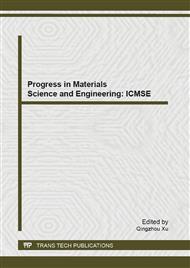p.3
p.8
p.13
p.19
p.25
p.31
p.37
p.43
p.48
Experimental Study on the Hydrogen Storage Properties of LaNi5 Alloy in Repeated Hydriding/Dehydriding Cycles
Abstract:
LaNi5 alloy is one of the promising materials for hydrogen storage. It has good activation property, fast reaction rate and moderate plateau pressure. However, some of its hydrogen storage properties will change after repeated hydriding/dehydriding cycles, which limits its practical application. Therefore, this paper investigated the cycling properties of LaNi5 alloy by volumetric method. The results showed that the reaction rate increased with cycling. The hydriding/dehydriding hydrogen content decreased with cycling. For hydriding reaction, the equilibrium pressure increased with cycling, while it decreased for dehydriding at 40°C and 60°C. After 100 cycles, the LaNi5 alloy has been severely pulverized and oxygenated. The oxidation products include LaNiO2, La2NiO4, La2NiO4.18 and LaNiO3. The JMA model was found to fit the kinetic data well, suggesting a nucleation and growth controlling mechanism. The intrinsic reaction rate constant ka increases from 21.87 s-1to 24.81 s-1, while the activation energy decreases from the initial value of 19459 to 19373 J/mol after 100 cycles.
Info:
Periodical:
Pages:
25-30
Citation:
Online since:
October 2013
Authors:
Price:
Сopyright:
© 2013 Trans Tech Publications Ltd. All Rights Reserved
Share:
Citation:


